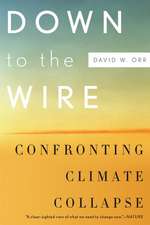Nitrous Oxide Emissions from Rice Fields
Autor Deepanjan Majumdaren Limba Engleză Paperback – 6 ian 2009
Preț: 302.67 lei
Preț vechi: 407.65 lei
-26% Nou
Puncte Express: 454
Preț estimativ în valută:
57.92€ • 60.62$ • 48.20£
57.92€ • 60.62$ • 48.20£
Carte disponibilă
Livrare economică 10-24 martie
Preluare comenzi: 021 569.72.76
Specificații
ISBN-13: 9781607411833
ISBN-10: 1607411830
Pagini: 134
Ilustrații: tables & charts
Dimensiuni: 154 x 225 x 9 mm
Greutate: 0.25 kg
Editura: Nova Science Publishers Inc
ISBN-10: 1607411830
Pagini: 134
Ilustrații: tables & charts
Dimensiuni: 154 x 225 x 9 mm
Greutate: 0.25 kg
Editura: Nova Science Publishers Inc
Cuprins
Preface; Introduction; Sources and Sinks of Nitrous Oxide; Global N2O Budget; Contribution of Agriculture VIS A VIS Rice Cultivation to Atmospheric N2O Loading; Importance of Rice in World Agriculture; Types of Rice Ecosystems; Processes Contributing to N2O Emission from Rice Fields; An Assessment of Special Conditions Driving N2O Emissions in a Rice Field; Factors Affecting N2O Emission from Rice Fields; Sampling Techniques of N2O from Rice Fields; Analysis of N2O; Problems in Sampling and Quantification of N2O from Rice Fields; Simulation of N2O Emissions from Agriculture VIS A VIS Rice Cultivation; A Review of Literature on N2O Emissions from Rice Cultivation; Effect of Land Management Practices in Non Rice-Growing Season on N2O Emissions from Rice Fields; Can Rice Fields Act As A Sink of Atmospheric N2O?; Emission Trade-Off between N2O and CH4 From Rice Fields; Positive Radiative Forcing of N2O Emitted from Rice Fields; Mitigation of N2O Emissions from Rice Fields; The Dilemma: Will the Mitigation of N2O Increase Emissions of CH4 from Rice Fields?; Cost of N2O Mitigation; Future Research Needs and Concluding Remarks; Index.













